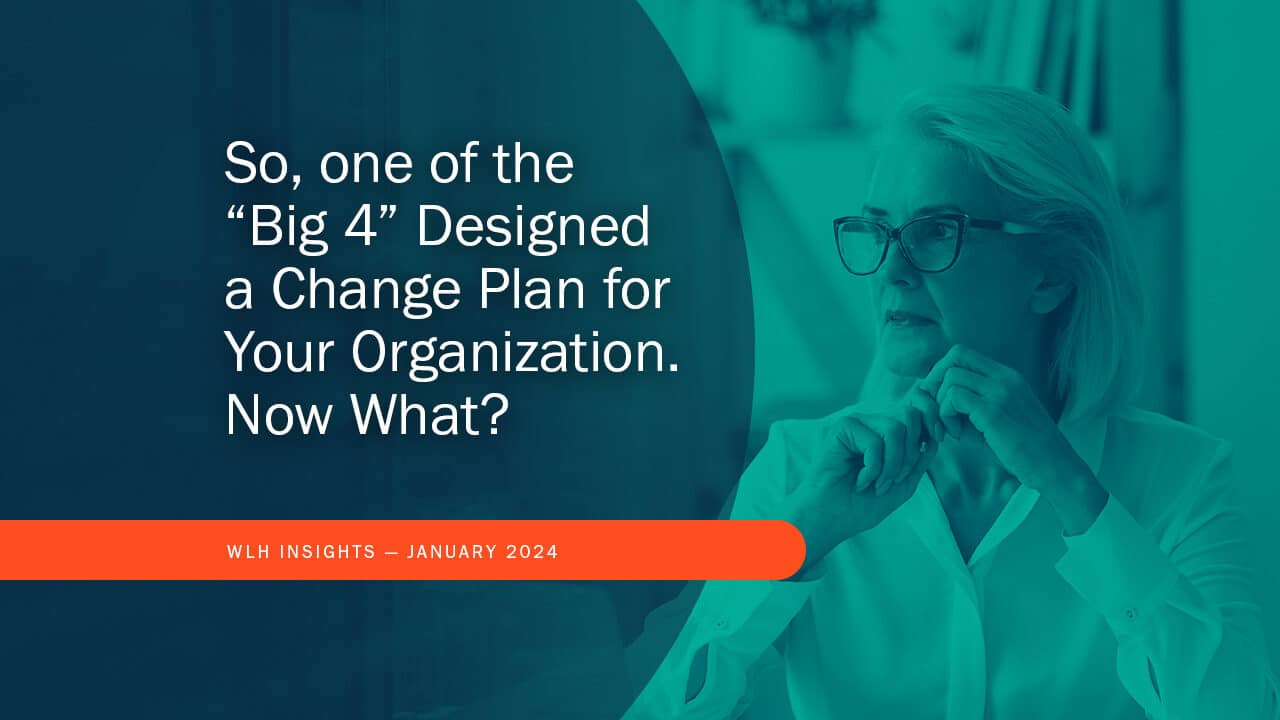Organizational Change Is Personal
In the dynamic business world, change is an omnipresent force, often shaping the landscape of industries, especially in the pharmaceutical sector. Companies continually redefine strategies, restructure, and adjust to market shifts; however, the true impact of these changes is not measured in boardroom presentations or high-level strategies, it is measured in the daily experiences of every individual within the organization.
Enter the revered Big 4 consulting firms. Their arrival heralds a wave of transformative change plans that encompass everything from reimagining structures to strategic realignments and refined communication practices. These plans can be transformative, no doubt, but here is the reality: they often resonate and translate more clearly with corner office occupants than with the unsung heroes of change—middle management and front-line leaders.
Their approach is intentional— designed to address critical organizational concerns on a macro scale. However, what often remains elusive is the translation and execution of these sweeping strategies throughout the organization’s ranks. These are the missing links—the crucial bridge between visionary strategy and on-the-ground implementation.
So, where does that leave you after the last project presentation and slide have been clicked through? What comes next once the polished presentation fades?
A key question remains: how can organizations ensure that leaders across every tier possess the tools to not just champion change, but to translate it into actionable, impactful steps?
Change Leadership: The Overlooked Key to Successful Organizational Transformation
Change management experts have highlighted the importance of change agents for decades. Kotter (2012) and others (Bossidy & Charan, 2002) speak about the importance of execution planning and working with change agents throughout multiple levels of the organization. And yet, many organizations misunderstand the power of equipping every single leader as a change agent by targeting development of one critical skill set – change leadership.
Change leadership refers to leaders’ ability to translate and execute organizational strategy by driving change adoption among individuals and across groups.
So, what distinguishes change leadership from change management?
| Change Management | Change Leadership | |
|---|---|---|
| Why | To define an effective and efficient change plan. | To drive change adoption within individuals, across teams… leading to organizational transformation |
| What | Strategic | Visionary and People oriented |
| When | Project Driven | Ongoing |
| Who | Often a dedicated role or external partner | Internally driven, regardless of role or title |
The Change Leadership Skillset
Schein (1985, 1992) highlights the significant role leaders play in shaping culture and overseeing the process of change within an organization. Leaders hold the responsibility of articulating the business case for change, steering teams through transition, and ensuring active engagement and motivation among all of the organization’s members. When leaders are provided with the necessary tools and resources to adeptly navigate and implement change, organizations enhance their prospects of attaining the intended results.
It is within this context that the proprietary 5C’s of Change Leadership® framework emerges as a valuable learning solution and tool. This framework serves as a roadmap for those seeking to enable leaders to successfully navigate the complexities of organizational transformation.
In the 5C’s model, Change Leadership encompasses five core areas:
- Commit to the Change
- Leaders need the training and resources to understand the importance and purpose of the change. Once they embrace and commit to organizational transformation, they are better suited to lead others to do the same.
- Construct a Risk Mitigation Plan
- Leaders have a unique vantage point that reveals risks in any change scenario. With proper training in risk assessment methodologies, decision-making frameworks, and strategic thinking, they will be positioned to work with their team to identify and proactively mitigate risks.
- Create High-Performing Teams Focused on Results
- The number one challenge for most leaders is keeping their teams engaged and focused on the business during times of change. Leaders who understand team effectiveness are better prepared to jump start their teams, whether there is a restructuring, new leadership, or even new strategic imperatives.
- Coach Individuals through Change and Transition
- As change unfolds, coaching becomes a pivotal aspect of navigating the transformation journey… but it is not the type of coaching that most leaders are accustomed to using. Leaders need transition coaching skills, to enable them to support individuals through the change process.
- Calibrate to Ensure Success
- Continuous evaluation and adjustment are essential in driving successful change. Leaders should be comfortable with data analysis, feedback mechanisms, and other complementary techniques needed to evaluate progress, identify gaps, and make informed adjustments to change strategies.
Conclusion: Embracing Change Leadership
While change management strategies can be transformative, change leadership stands as the linchpin for successful plan implementation. Empowering leaders at all levels to champion change, communicate effectively, and navigate the intricacies of change will ensure a smoother transition toward desired outcomes. Organizations that prioritize change leadership will not only survive but thrive in the face of ongoing change and strategic transformation.
